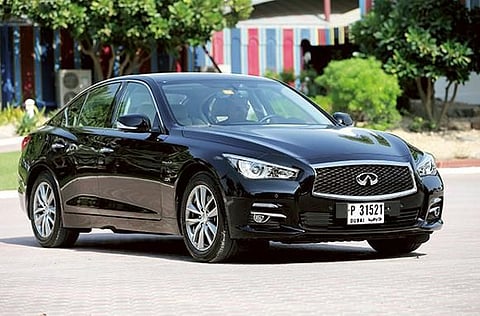Infiniti Q50 tested
Nissan’s luxury arm, Infiniti, has had a quarter of a century to match the Germans

Since Nissan launched the offshoot luxury brand 25 years ago, this could be the first time Infiniti’s finally managed to match the Germans. The hybrid Q50 is largely irrelevant in our market and the 3.7-litre Q50 model is in that territory where buyers have money to spend. That means they’ll spend it on gleaming three-pointed stars, chromed four rings or creditable blue and white roundels. But there is now another Q50 for Infiniti to bank on.
And down at its level, in the premium basement where, at a push, you’ll find a fully loaded Nissan Maxima or Kia Cadenza, this little new Infiniti starts to make a lot more sense. It’s just a pity sense has nothing to do with premium purchases. Otherwise anyone buying an Infiniti Q50 would wisely get this 2.0-litre turbo option. Of course, they’d first have to conclude that it’s better than a BMW 3 Series, an Audi A4, a Lexus IS, a Cadillac ATS, and the new Mercedes-Benz C-Class. It’s not, but it fights back to match its rivals by representing better value…
And that keyword, value, isn’t something Infiniti should cling to tightly. Kias are good value, Hyundais are good value. They are anything but premium though. And Infiniti, in its own words, reckons the company’s biggest hurdle in approaching targeted annual sales of half a million is brand perception. Currently the company’s portfolio also includes the G saloon, which I think it’s about to start rebadging Q40, and badge-engineers Nissan Pathfinders and Patrols. Brand perception has a long way to go, indeed.
What you’ll find if you check out the Infiniti, is that it’s nigh on imperceptible from the 3.7 model or the Q50S, which is good if you’re the 2.0 owner and bad if you’re one of the other pair’s drivers. That means the base model starts racking up that value position, packing in all the kit you’ll otherwise get in its more expensive siblings.
There are the around-view monitors, Bose sound and intelligent cruise control – which is annoying because it can’t be switched off and the technology is utterly useless in our region anyway, because it maintains a safe distance from the car in front, meaning a Patrol is just going to swing into the gap and cut you off. Then there’s distance control, braking assists and, really, just a heap of standard-equipment techy bits that you would never find in an entry-level Mercedes or BMW. As an example, there are two big central displays. Of course, two screens where we’ve become conditioned to expect one is just plain weird. I’m not saying it’s wrong, but it is weird. You don’t have two TV sets sitting next to each other in your living room, but Infiniti seems to be asking, why not? The bottom touchscreen also doesn’t confine key controls to, say, two little corners of the display surface, so you end up touching all over the place and smudging the entire thing with your fingers. After one day it’s icky and disgusting.
Then there’s a standard stop-start included, which is just bad. It can’t compare to its rivals’ seamless systems, which you can’t detect, because Infiniti’s is abrupt and bursts back into life with all the ‘premiumness’ of an earth mover.
A positive, you might think, would be the steering. Infiniti ditched the dreaded steer-by-wire found in the bigger Q50S and 3.7-litre models, and stuck with a conventional, mechanically linked rack and pinion steering system. It sort of ends up being an improvement, plainly because it’s so easy to improve on the lifeless steer-by-wire, not because it’s actually very good. It’s artificially weighted, too, and eventually becomes cumbersomely heavy.
No complaints about the actual physical act of steering; turn right, and the car goes right. Repeat in the opposite direction as required.
Of course, this being the entry-level Q50 2.0L, as it’s badged, the biggest change is the 2.0-litre four-cylinder direct-injection turbocharged engine. The click and clatter of the direct injection makes it sound rough, like a diesel, and the unit’s not really in the same league as BMW or Mercedes four-cylinder turbos in terms of refinement and flexibility. But get away from the lower revs and Infiniti’s 208bhp feels like more, and the car becomes quite urgent on its way to a nice, comfortable 140kph. It’s pleasant on the move, economical too. In fact that’s what it is, economical, considering the amount of stuff you get for Dh145,000. Everything, basically, except the right badge.
Sign up for the Daily Briefing
Get the latest news and updates straight to your inbox




